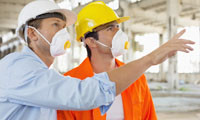

In Great Britain alone, there are an estimated 12,000 lung disease deaths each year linked to past exposures to dust at work.
In this article, Dust control experts Renby Ltd outline the dangers of dust, your responsibilities as an employer and top tips to achieving compliance with government standards on dust regulation.
Types of dust
There are many types of dust that you may experience in the workplace from metallic dusts to chemical dusts. However, all dust exposure can be categorised into two types.
1. Inhalable dust is the larger of the two types of dust most of which can be filtered out in the nose and throat
2. Respirable dust is the more dangerous category. The dust particles are smaller and therefore are not filtered out by your nose or throat. They can penetrate the pulmonary alveolar region of the lungs and cause you serious health problems with prolonged exposure.
Why is dust suppression important?
Exposure to dust at the workplace is a problem both employers and employees should be aware of, as It can lead to a multitude of different health problems, ranging from the mildly serious to the life-threatening. Here are some of the conditions dust exposure can cause and exacerbate.
Asthma - This common, long-term chronic disease can be severely induced by dust exposure and inflammation, drastically affecting how it can be managed.
Silicosis - Respirable crystalline silica (RCS) causes inflammation and fibrosis of the lung tissue if exposed to over a prolonged period. Symptoms include a persistent cough and shortness of breath. The effects are irreversible and can often become worse years after the initial exposure, with an estimated 500 construction workers dying each year.
Chronic obstructive pulmonary disease - Chronic Obstructive Pulmonary Disease contributes to 33% of current annual deaths from occupational lung disease.
Lung cancer - Lung cancer is a serious health hazard from exposure to dust with an estimated 43% of annual deaths from lung disease at work being due to asbestos and non-asbestos related lung cancer.
What are your responsibilities as an employer?
There are many forms of Government legislation that are aimed at minimising the amount of dust at the workplace. The Factories Act 1961, the Health and Safety at Work Act 1974, the Control of Substances Hazardous to Health Regulations 1988 and The Coal Mines (Respirable Dust) Regulations 1975 are the most significant that have to be aware of as an employer.
It is important to read and process these legislations because they all state the employer is responsible to make the environment safe and suitable for their employees. This means that you are legally and morally liable should you not adhere to them.
The impact that exposure to dust in the workplace can have is dangerously overlooked by all parties. In a survey of UK construction professionals in 2012:
5 tips to keep you safe from dust exposure
1. Reduce the dust emission from source
This is the crucial step if you want to stop most of the health hazards associated with dust. By stopping the dust from source, you are drastically reducing the total amount of occupational dust present. Understand the products you sell and the procedures that take place in your work environment. Can anything be modified or replaced to reduce the emissions from source? Perhaps Instead of using solvent-based products, switch to water-based products. If your application requires spraying, consider whether it can be applied with a brush to reduce airborne dust.
2. Follow safety instructions
This may seem obvious, but it is surprising how many employers and employees do not follow the safety instructions written for their benefit. Being aware of how dust can be generated from products, machines and procedures is essential to complying with government safety standards. Read product labels, put up warning signs in your workplace and know how all your equipment might produce harmful dust. Knowing the government regulations on safety and being proactive about reducing dust in your workplace is imperative when complying with government standards.
3. Provide employees with protective gear
It is legally required of you as an employer to provide your employees with full safety wear and protective gear. That means protective clothing suitable for the levels of dust your employees will be experiencing. Dust filtration masks and respirators are a must and need to be invested in to ensure your employees safety and for you to comply with government standards.
4. Understand when and how to use the control measures you’ve set up
It is essential that once you have these safety procedures and measures in place that your employees are aware of why you have them and what they do. This means educating them on the processes, the importance of this cannot be underestimated. Awareness of the dangers of dust is something that needs to be improved and it is your responsibility to educate your employees on this.
5. Have an effective dust suppression system
If your workplace produces dust to any degree then you should invest in a dust suppression system, that is economical and easy to maintain. By installing a dust suppression system in your workplace, you will be able to reduce dust exposure in the workplace to the legal required levels.
For more information the Control of Substances Hazardous to Health Regulations (COSHH) has direct advice sheets sorted by industry to help you understand the dangers and processes you must follow, in order to achieve optimum dust standards.